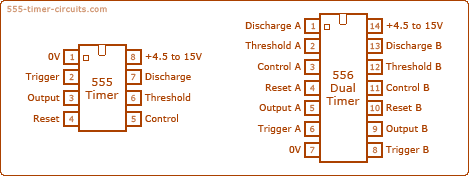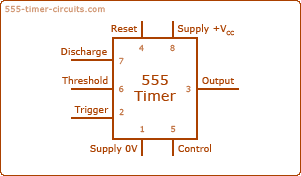An Overview of the 555 Timer
The 555 Integrated Circuit (IC) is an easy to use timer that has many applications. It is widely used in electronic circuits and this popularity means it is also very cheap to purchase, typically costing around 30p. A 'dual' version called the 556 is also available which includes two independent 555 ICs in one package.
The following illustration shows both the 555 (8-pin) and the 556 (14-pin).

In a circuit diagram the 555 timer chip is often drawn like the illustration below. Notice how the pins are not in the same order as the actual chip, this is because it is much easier to recognize the function of each pin, and makes drawing circuit diagrams much easier.

For the 555 to function it relies on both analogue and digital electronic techniques, but if we consider its output only, it can be thought of as a digital device. The output can be in one of two states at any time, the first state is the 'low' state, which is 0v. The second state is the 'high' state, which is the voltage Vs (The voltage of your power supply which can be anything from 4.5 to 15v. 18v absolute maximum).
The most common types of outputs can be categorized by the following (their names give you a clue as to their functions):
- Monostable mode: in this mode, the 555 functions as a "one-shot". Applications include timers, missing pulse detection, bouncefree switches, touch switches, frequency divider, capacitance measurement, pulse-width modulation (PWM) etc
- Astable - free running mode: the 555 can operate as an oscillator. Uses include LED and lamp flashers, pulse generation, logic clocks, tone generation, security alarms, pulse position modulation, etc.
- Bistable mode or Schmitt trigger: the 555 can operate as a flip-flop, if the DIS pin is not connected and no capacitor is used. Uses include bouncefree latched switches, etc.



